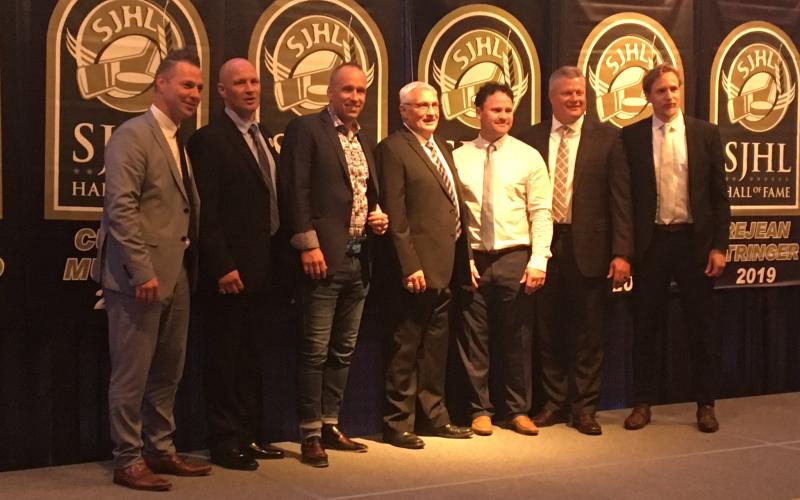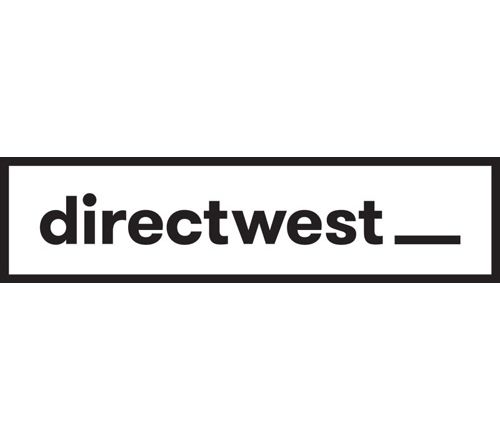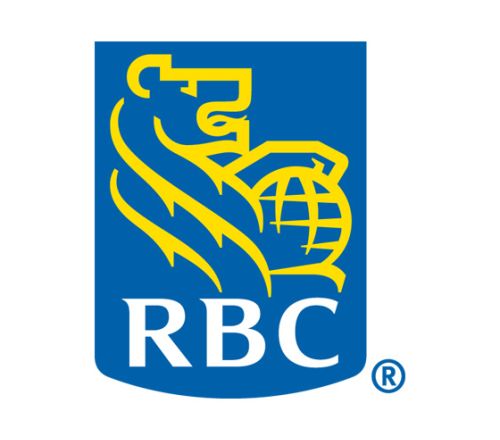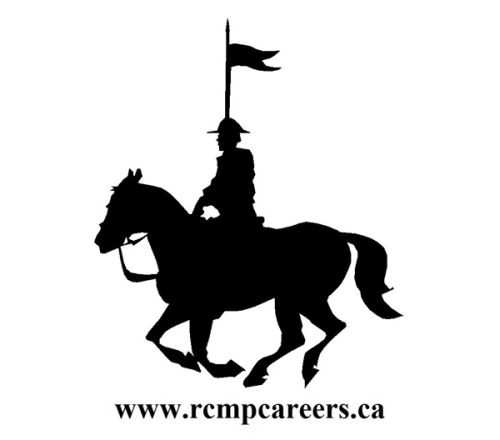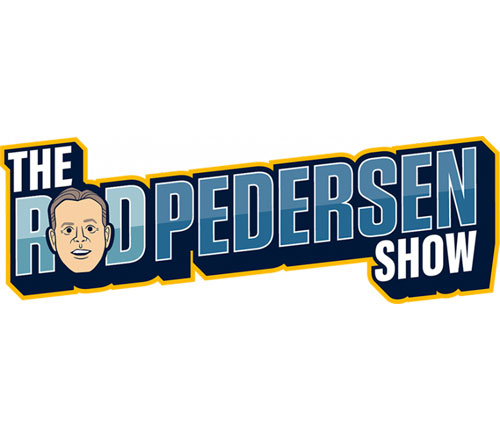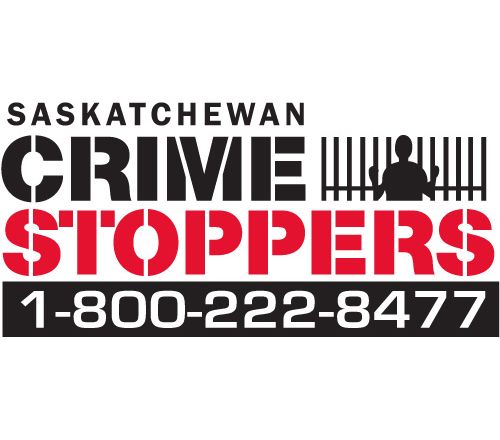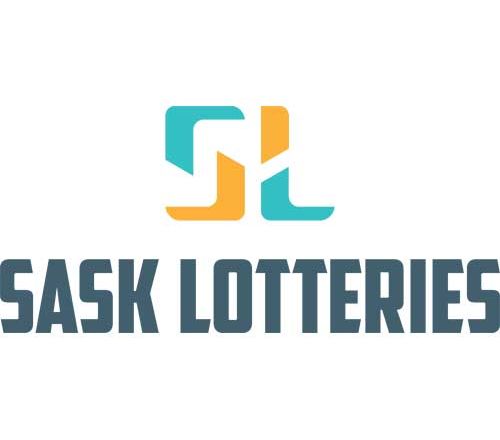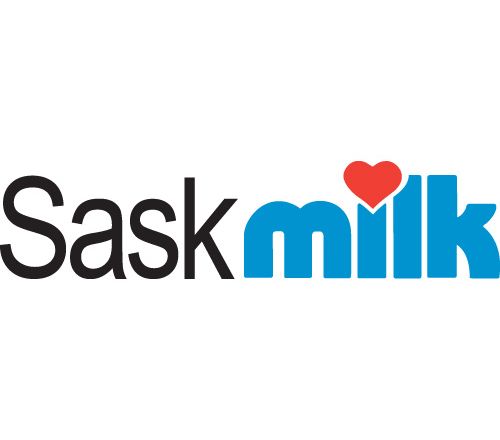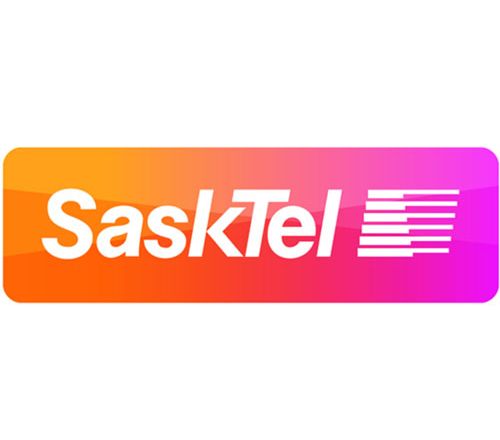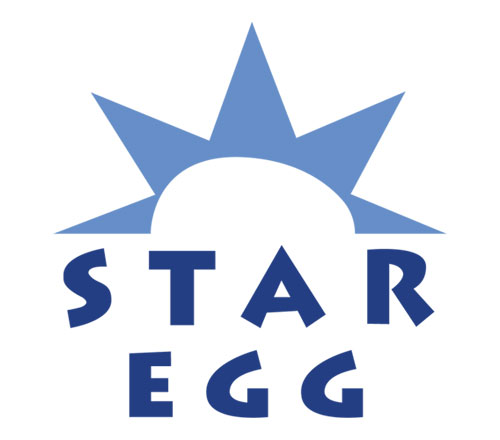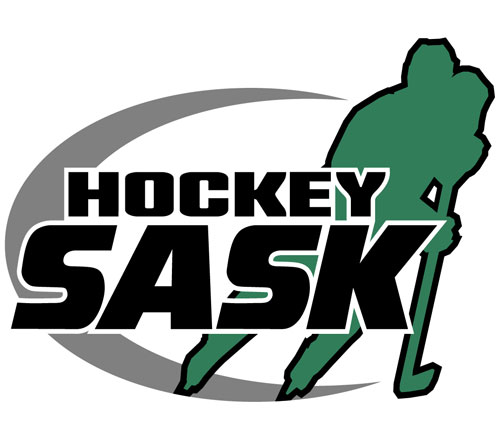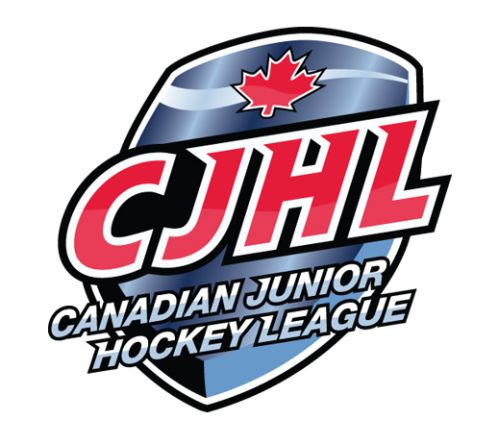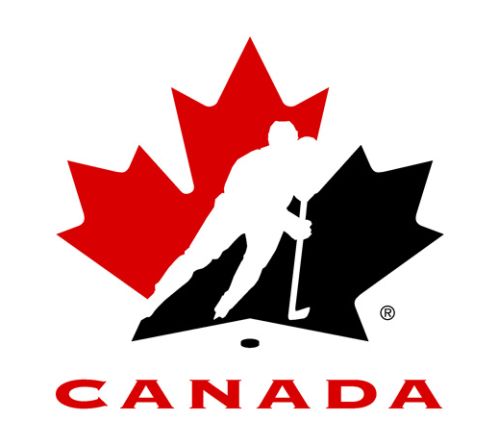INDUCTION CEREMONIES HELD IN NIPAWIN AUG 3, 2019
Mark Smith
Mark Smith was born in Edmonton, AB., but moved to Saskatchewan at the age of 3 and grew up on a farm, 15 miles from Eyebrow, SK. Mark has an older brother and sister, and they kept each other busy making up any games their minds could invent, as well as working on the farm, just like any young kid from Saskatchewan, to help the family business of farming stay afloat. Little did he know, he was learning what hard work and dedication meant, and thought nothing of it, as this was all I knew.
Childhood
At a young age, Mark remembers hockey always being a big part of their household. Being born in Edmonton, and having a lot of family from there, it was easy to be an Oiler fan growing up in the ’80s. Saturday nights were usually spent adjusting the rabbit ears and crowding around the TV to watch the Oilers make easy work of whoever their victims happen to be that night. If we were lucky, Channel 4 looked more like a hockey game than a snowstorm, and we could watch our heroes, Gretzky and Messier work their magic. It wouldn’t take long before number 11 would become my childhood hero, primarily because we shared the same name, but as Mark watched his game evolve over the years, it would be his tough style of play, coupled with his extraordinary skills, that would be the blueprint he would pattern his game after. Just like any other kid that would dream of being their hero, Mark adopted the love for number 11 and claimed it to be “his number”, something that every player holds as being sacred throughout their careers.
At home, Mark and his siblings started skating on a frozen ditch during the winter, but after a lot of begging, convinced their dad to level some ground and make a rink we could flood. Over the years, the rink would evolve, but we could never seem to really dial it in. It always seemed that one end had really good ice, and the other end would be, “dodge the dirt clumps”. We would also eventually convince dad to let us skate on the pond outback. But that was usually 3 hours of scraping snow for about 20 square feet of ice, then usually 2 mins of hockey, before someone shot the puck into the bushes, and the game was over.
Mark spent a lot more time their basement, which their parents let them convert into a hockey rink, we had full-on boards that we had got from ripping down an old grainery and built nets out of 2 by 4’s and chicken wire. There were many intense battles between Mark’s brother and him, and more than a handful of fights to go with it… but I really feel like this was where I started to really develop my skills. Tight area stickhandling, puck protection, and creative dangling. This was a daily occurrence for us now that we didn’t have to battle the elements. Mark remembers spending hours down there and coming up pouring sweat. It was absolute, pure joy for him.
Growing up on the farm, they didn’t have too many options for places to play hockey, just the local team made up of all the farm kids. They spent their early years playing at Brownlee, SK., where they actually had an indoor rink with boards, but in the years to come, after showing our parents that we truly loved the game, and showed some promise. We talked them into making the 30-minute drive to Central Butte, where they actually had artificial ice and a real Zamboni. This meant we didn’t have to watch our parents get out the shovels between periods, and scrape the snow. It was amazing to play on freshly cut ice.
Hockey Career
Central Butte had one of the best hockey programs in the area, and Mark was so excited to play there. Mark remembers being in awe of the older kids, and seeing how good they were, and dedicated to winning. I remember watching Dallas and Clarke Wilm and wanting to be able to play like them. Mark remembers Clarke looking and playing like Messier, which of course blew my mind, and since they played on my brother’s team, I would study their moves, steal them, and then use them against the guys I played against. Little did Mark know, this was the start of how he would develop as a player. Mark would focus on the players that he thought were the best, and copy their moves, and style. This was how he got good and broadened his skill set. Mark would only take their best skills and habits, practice them, and add them to his toolbox. He did this all the way to the NHL. Here is a list of players Mark played with at one time or another and stole something from each of them. His game has at least one part of each of these players in it. Mark credits all of them for helping him get to the NHL. *Derek Smith, Clarke Wilm, Chad Reich, Jason Cowan, Rejean Stringer, **Byron Richie, Steve Guolla, Dan Boyle, Vincent Damphousse, Scott Thornton.
* Mark’s brother was the guy that ultimately pushed him, and is the sole reason Mark made it as a hockey player. He remembers that he didn’t really have the drive he did or the ambition to win. He only learned this after being constantly beaten down, and losing time and time again, coupled with the taunting and ridiculing of being a little brother and a loser. Somewhere along the way, Mark got tired of it and realized he had to push myself if he ever wanted to beat him. He pushed me to train, to believe in myself, he taught me to win. I won 1 fair fight against him in my life, the last one we had. That was the moment we became best friends. Did I mention he was a very smart hockey player too?
** Byron Richie is the player that influenced Mark’s style the most. In my heavy development years from 17-19, Mark watched and copied his style as closely as he could. Ritchie’s drive, speed, hockey sense, defensive play, and offensive punch, was the most complete Mark had seen in any hockey player. Ritchie probably isn’t aware of what an impact he had on Mark’s career, but without watching him for 3 years, Mark would not have evolved into the player he became.
Mark remembers at this point in my journey, his parents were 100% dedicated to allowing him to push my career as far as he could. At times he would get distracted easily, and focus was never his strong point. Mark remembers his Dad taking him out to the garage one day, and pounding a nail into the wall, he told me.
“If you don’t want to play hockey, we’ll hang your skates on the wall, and you never have to play again. We won’t be disappointed and will support you 100% in your decision. If you do want to play, we will drive you all over the countryside and support you 100%, but if we dedicate our time and effort into doing this for you, we expect you to put in the same effort.” Without being demanding of me, he put the responsibility into my hands. This was the encouragement I needed and started to realize the sacrifice everyone else had to make, to allow me to do what I loved. They never had to encourage me again, and the way they supported me would be a huge contributor to my success. I’m very thankful for their support and encouragement over the years.
Once Mark was of bantam age, he left Central Butte and headed to play in Moose Jaw, SK. After years of his dad trying to convince Moose Jaw that we lived in their “zone” for hockey, they finally agreed to let us “try-out”. Mark would be lying if I said that politics had nothing to do with how these teams were formed, but against all odds as the “out of towner”, he won the respect of his coaches, and they agreed to keep me on the team as the “last spot”. Lloyd Dobresku and Doug Mason would be his coaches, and this would later play an important role in the following years. He played 2 full seasons in Moose Jaw, and during his second year, he would get the chance to play with his older brother a few times, as a call up to the midget “AAA” team. This was a pivotal time in his career, as a young coach by the name of Curt Folkett, who happened to be an assistant coach at that time.
During the offseason, things looked to be aligning that he would go back to Moose Jaw, and play for the Midget AAA team. However, he received a letter that summer from a team called the Nipawin Hawks. It seems that they had picked up a new coach by the name of Bruce Thompson, as well as hiring a new assistant coach, Curt Folkett. The letter stated that both Mark and his brother had been put on their protected list, and they wanted us to come to camp that fall and try out. For any kid that played hockey in Canada, playing junior hockey was the ultimate goal. Mark remembers the excitement that he felt, and how playing AAA, seemed more like a consolation prize now. With his sights were set on the SJHL, and it seemed like finally, someone wanted to give us an actual opportunity, not just a team that made us feel like they were doing us a favor by letting us play. Mark packed his most trusted assets, my hockey gear and my stereo. As we were leaving, Mark’s brother asked, “Why are you bringing your stereo?”
To which I simply replied, “Because, I’m not coming back”.
At 15 years old, Mark would leave for Nipawin and never live at home full time again. I’m sure this was harder on my parents than it was on Mark.
Mark played one season in the SJHL and learned a lot. Playing in a league that was much older, and had a lot of 20-year-olds was challenging. Mark remembers how smart the players were compared to what he was used to. They would “suck you in”, and then make soft plays behind you to open ice. The speed of the game was no longer how fast you could skate, but how fast your brain could process information, and move the puck. He was no longer playing against boys, he was playing against men. This unfortunately also transitioned into what happened between whistles, where the strength of these men was evident. I had my first real hockey fight in the SJHL, actually, I had 6 of them that year. My record was 0-6; punches thrown: 0; punches taken: too many. Mark knew if he was going to survive, he would need to toughen up. Mark had never experienced such hard work and dedication. The drive to win and the sacrifice it takes to be successful, on and off the ice, was a complete eye-opener for him. Something changed inside Mark’s mindset during that season. Mark learned what it meant to sacrifice for a teammate. He felt the passion to win and the angst of defeat. The coaching and self-confidence he gained, was definitely a huge steppingstone for him, and ultimately prepared him for the coming years. This was an awesome year for him, and a key point in my journey to the NHL.
After that season, Mark was presented with another opportunity, his old coach in bantam, Doug Mason, had started scouting for the Lethbridge Hurricanes, he reached out to Mark, and told me that they had “listed him”, and put me on their protected list. At 16 years old, Mark was forced to make a career-altering decision. He could return to Nipawin, or take my chances and try to make the WHL. With scholarship eligibility on the line, Mark decided to roll the dice and go the WHL route. At this point in his career, he was all about taking giant leaps of faith. Mark went into camp in Lethbridge, and at 16 years old, he would claim the “final spot” on the team. After playing in just 49 games his first season, and getting very limited ice time, it looked as though he had made a bad decision, but if hockey had taught him anything in life, It was to “get up, and don’t feel sorry for yourself”. It seemed he would get a break, as a coaching change would take place, early in my second season, it seemed much of the same from the new coach. No ice time, and no idea of what he could bring to the table. Then, just 24 games into the season, they would fire the coach, and bring in a new coach by the name of Bryan Maxwell. This was the exact moment that changed his career and ultimately allowed me to make the NHL.
From the start, Bryan saw something in Mark’s game that he liked, and Mark started getting more opportunities. By the end of the season, he was playing a solid 3rd line position, as well as first line penalty kill. Some key trades and acquisitions brought toughness, and skills to the team. The team started to believe and the makings of a great team and started to dominate the league. At the end of his first season with Bryan, he remembers Bryan calling in me into the office at the end of the year. He told Mark he would score 30 goals in this league… Mark thinks he burst out laughing. Mark’s last year with Bryan, he scored 42 goals, 67 assists, 109 pts, and 206 PIM. He was right, and he gave me the belief that Mark could play in the NHL.
Mark’s 3rd season with the Hurricanes was by far the best season of his career. The team was an amazing team and ended up winning the WHL. They would eventually fall short by losing in the Memorial Cup finals against Hull, Quebec, in Hull, Quebec (go figure, lol). However, a guy by the name of Patrick Marleau was a highly touted draft prospect, and the Hurricanes just so happen to meet his team in the WHL finals that season. Mark’s job was to shut down Patrick Marleau and the Hurricanes ended up sweeping them in 4 games. Mark believes this is where he caught the eye of the San Jose Sharks, who were obviously scouting Marleau quite heavily at that time. The sharks would go on to pick Marleau 2nd overall in the draft that year. They would also make a selection in the 9th round (219th overall) for a guy by the name of Mark Smith.
After getting drafted, Mark returned to Lethbridge for one more season and after exiting the playoffs that year, he would be sent to play a few games in the playoffs for the Kentucky Thoroughblades, San Jose’s farm team. After signing my first contract with San Jose, which was a standard entry-level contract for 3 years, he would return to Kentucky for the next 2 season’s and play for Roy Sommer. There was a really good group of guys, and he enjoyed playing there, but like any player, his sights were set on the NHL.
Mark would make my NHL debut in San Jose on Oct 6, 2000, in a loss against the St. Louis Blues. Skating through the Shark head was a surreal moment, as all of the childhood dreams he had come to fruition in a single moment. He would go on to play 7 more seasons in the NHL, 6 for the Sharks, and 1 for the Calgary Flames. he would end up injuring his neck on a hit, which would ultimately be the deciding factor for my retirement from hockey. He was 30 years old at the time. Mark ended his NHL career playing 377 games, scoring 23 goals and adding 37 assists. He also added 457 PIM. Mark appeared in 24 playoff games and added 4 goals, 0 assists, and 21pim.
Life after hockey
Since his retirement from hockey, his wife Andrea Alvardo-Smith and he have had 2 wonderful children, Camila (11) and Lucca (9), who are both avid hockey players in San Francisco, where they call home. Mark now a coaches for the San Francisco Sabercat hockey organization and gets to spend a lot of time at the rink coaching them, as well as other up and coming hockey players. His wife is a fashion designer and has her own clothing line called Ayla (pronounced I•la) aylaclothing.com.
After hockey, Mark decided to build a website to support his wife’s business. After several books and sleepless nights, Mark soon found myself immersed in the code, and was entering a world that would soon consume him. A world of websites, shopping carts, database storage, point of sale systems, payment gateways, and building fully dynamic applications. Over the next 8 years, we would sell our home in San Jose and move to Cabo, Mexico, where he taught himself to code, building web and iOS applications. In 2016, we would return to San Francisco, where he would start work for a startup company called PagerDuty. Over the next 3 years, the company would grow exponentially, and on April 11, 2019, PagerDuty would become a public company, trading on the NYSE as “PD”.
Life in San Francisco is pretty amazing, and there is always something to do or see. Mark and his wife value the diverse culture there and love the amazing opportunities that it presents for our children. Mark uses the gifts that hockey has given him every day of his life. Mark once overheard a wise coach tell his parents, “We aren’t teaching your kid to play hockey, we’re teaching him life skills.”
At the time Mark was like, “ya, whatever, I just want to play hockey.”, but as life evolved, he used those life skills a lot more than any “toe drag” someone taught me along the way. He continues to reap the benefits the game of hockey has given to him. The real beauty of the game is, you don’t need to play in the NHL to leverage it. It’s in every hockey player that has ever played on a team and learned those hockey values. Hockey is life.
Nolan Schaefer
Nolan Schaefer was raised in Yellow Grass Saskatchewan by his parents Peter and Tracy Schaefer. Nolan’s brother Peter was a long time NHL left winger and Gold Medalist for the Canadian World Junior Hockey Team, sister Falin played for the Canadian National Volleyball Team.
During Nolan’s time spent with the Nipawin Hawks, Nolan committed to Providence College where he played four years and graduated with a Bachelors Degree in Fine Arts and a Minor in Art History.
Nolan was named an All American in his Sophomore season as well as the New England Sportswriters Award and Hockey East All Academic Team. He holds the record for most career saves as a goaltender for the Providence College Friars. During his four years in College, Nolan met his wife Lisa and was married at the age of 25.
After his sophomore year at Providence Nolan was drafted in the 5th round to the San Jose Sharks. Nolan went on to play for three seasons in the San Jose Sharks organization. The highlight of his playing career came when he entered the NHL with a 5-0 rookie season start boasting a .920 SVS% and a 1.87 GAA. Unfortunately, that would be the last time Schaefer saw NHL ice. However, he spent many very good seasons in the AHL finishing first in league statistics with the Minnesota Wilds minor league team, the Houston Aeros and playing in the AHL All Star game.
Nolan then made his first venture to Europe by playing one season in the KHL for the CSKA or Red Army under General manager and head coach Sergei Nemchinov. He then attempted to make a comeback into the NHL by signing with the Boston Bruins in 2011 where the team went on to win the Stanley Cup backstopped by Tim Thomas. From there he signed in Ambri-Piotta of the Swiss NLA and received his Swiss passport and finished his last four years in Switzerland.
Amidst all of the hockey movement and playing for over 12 teams, Schaefer’s wife Lisa became severely ill after there first year of marriage in 2005. They spent 7 years during his career going to doctors and specialists trying to find a cure for an unknown and life-threatening illness. The visited over 50 doctors and specialists in 2007 and spent hundreds of thousands of dollars on non-traditional medical therapy’s and treatments. At the end of the 7 years of treatments and anti-biotics Schaefer and his wife refocused their life on God and living the message of Jesus.
Less than three months later Lisa was free of illness and living her life as if nothing had ever happened.
Nolan retired 4 years ago upon the birth of their second daughter to continue the victories of his family life at his new home in Milford, Connecticut. At this time, he joined forces with former New York Rangers goaltender Steve Valiquette in coaching goaltenders for a business called Clear Sight Development and a cutting-edge hockey analytics company called Clear Sight Analytics. Clear Sight Analytics’ growing client list includes the Toronto Maple Leafs and several other NHL Teams and is expected to change how hockey is viewed with a ew perspective on the game.
Nolan now lives with passion and a love for God, fatherhood, marriage, and mentoring young goaltenders and local youth at his Church in Milford. He lives happily with wife Lisa, daughter’s Bella, Rose, and baby Nolyn…. To be continued!!!!













